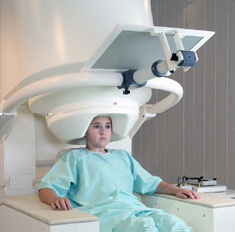Traumatic Brain Injury (TBI) patients may now have access to an older technology that is just becoming widely available today. Magneto-encephalography (MEG) brain scans can help doctors see the physical evidence of TBI. Technology like this ensures that those with brain damage can prove their injuries and therefore receive appropriate treatment and eligibility for programs designed to help those with TBI.

MEG Scanners
MEG machines resemble enormous thrones. The patient sits in a chair under the scanner, with his/her head inside what looks something like a big hat. Due to the size and complexity of these machines, only 20 exist in the United States.[1] The scanners can identify damaged brain tissue from TBI in 90 percent of cases. Compare that the Magnetic Resonance Imaging (MRI), which can only identify one case in 10.
To receive a scan, the patient must sit with his/her head in the scanner for five minutes, alternately opening and closing his/her eyes so that the scan can take a picture of the brain in its resting state. The scan appears on a computer screen, showing parts of the brain with abnormal activity. MEG can pinpoint damaged functional areas, offering evidence of brain damage and helping doctors target areas needing treatment.
Coexisting TBI and PTSD
Because the scans are so effective at identifying brain damage, doctors hope the scans will help them differentiate TBI from Post-Traumatic Stress Disorder (PTSD), a condition commonly confused with TBI and often seen in conjunction with it. Each condition responds differently to treatment, yet shows strikingly similar symptoms. At this time, doctors do not know if PTSD is a symptom of TBI that only affects some patients or if PTSD is a separate condition brought on by the trauma associated with TBI.
Old Technology, New Uses
MEG technology came into use in the 1960s. Researchers only saw the scanner’s true potential recently with the development of stronger computers and better hardware. Only 100 scanners exist worldwide, each one costing as much as $2 million each.[2] Despite the high price tag, the MEG is becoming a popular piece of equipment for brain research.
Magneto-encephalography works by tracking the magnetic signals from neurons as they communicate in the brain. This creates a visual representation of brain cells communicating in real time. Doctors can see which functions are active in the brain versus those that are communicating poorly or not at all.
While the MEG cannot inspect the physical parts of the brain, it can provide incredible detail when reviewed alongside an fMRI (functional magnetic resonance imaging scan). The fMRI shows blood flow through the different parts of the brain, while the MEG shows how those areas respond to stimuli.
Contact Us
If you or someone you love suffers from severe traumatic brain injury, contact our office for a free consultation. Our experienced attorneys will discuss your case, learn the facts and help you decide if you should file a brain injury lawsuit.
[1] http://www.kpbs.org/news/2011/may/30/meg-brain-scan-tracks-scars-traumatic-brain-injury/
[2] http://www.wired.com/medtech/health/news/2007/01/72277



What states have the meg scanners? Please advise and thank you.
Emma Lou Davis